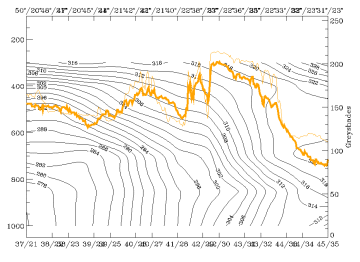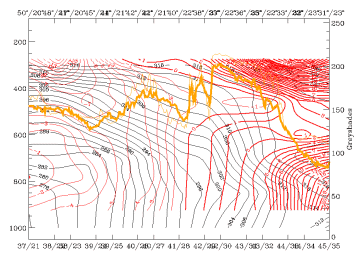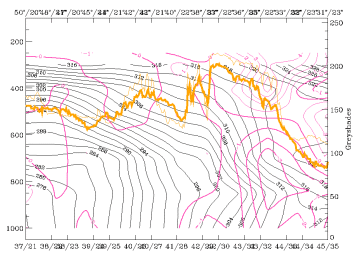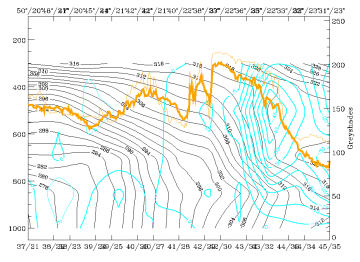06.00 UTC - Frontal Diagnosis - Use of vertical cross sections
|
15 March 1998/06.00 UTC - Meteosat IR image; position of vertical cross section indicated
|
15 March 1998/06.00 UTC - Vertical cross section; black: isentropes (ThetaE), orange thin: IR pixel values, orange thick: WV pixel values
|
Vertical cross sections are a very useful tool for identifying and diagnosing synoptic systems such as fronts in respect to their quality and intensity. In the right image isentropes and satellite pixel values are used to characterize the synoptic situation for both frontal zones. The peak around 42N/22E corresponds to the Cold Front in Cold Advection, the small peak at 39N/21E to the deformation band and the broad peak between 39N/21E and 36N/23E to the Warm Front cloud band. Two frontal zones can be identified in the isentropes by downward inclined crowding zones, both of which reach the surface: the northern one at 42N/22E, the southern one at 33N/22E. The southern frontal zone shows superadiabatic behaviour from the surface up to 850 hPa.
|
15 March 1998/06.00 UTC - Vertical cross section; black: isentropes (ThetaE), red thin: temperature advection - CA, red thick:
temperature advection - WA, orange thin: IR pixel values, orange thick: WV pixel values
|
|
Additionally, temperature advection is superimposed in the image above. Confirming what has already been diagnosed with help of the TA on isobaric surfaces, the vertical cross section shows that the northern zone is completely under the influence of CA with the strongest values below the isentropic crowding zone. The southern zone is under the influence of WA up to 500 hPa with WA within and in front of the frontal zone; this represents the upgliding warm air.
|
15 March 1998/06.00 UTC - Vertical cross section; black: isentropes (ThetaE), magenta thin: divergence, magenta thick: convergence,
orange thin: IR pixel values, orange thick: WV pixel values
|
15 March 1998/06.00 UTC - Vertical cross section; black: isentropes (ThetaE), cyan thick: vertical motion (omega) - upward motion, cyan
thin: vertical motion (omega) - downward motion, orange thin: IR pixel values, orange thick: WV pixel values
|
Divergence (left image) and vertical motion (right image) in the vertical cross section reveal that the southern frontal zone is very well developed with a distinct zone of convergence within and divergence aloft, leading to pronounced upward motion on top of the frontal zone. Thus there is a pronounced frontal circulation cell connected with the warm front in the Aegean Sea. However, the Cold Front in Cold Advection is not at all accompanied by these features. There is divergence and only very weak upward motion in a low layer, and sinking above. This is a typical feature for some of the Cold Fronts in Cold Advection (CF in CA).




